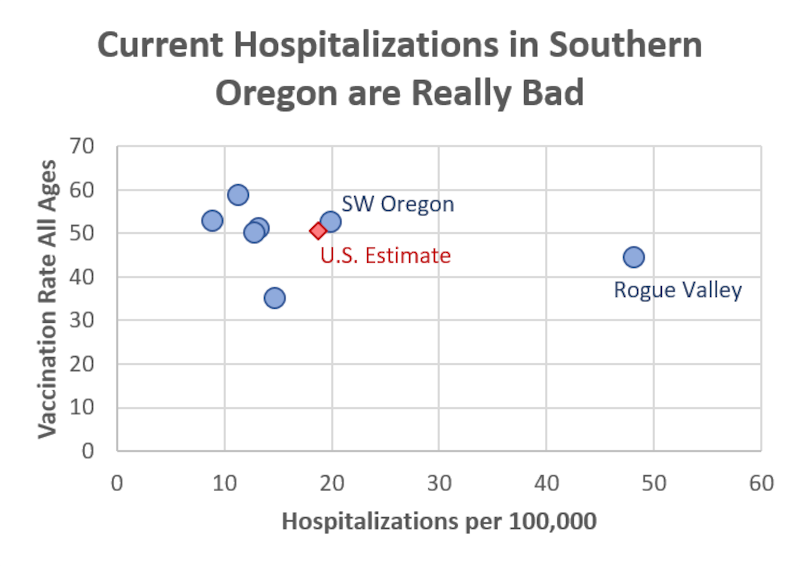On Aug. 13, Gov. Kate Brown announced she was deploying 500 National Guard members to hospitals to assist with care for people sickened by the Delta variant of the coronavirus.
“This morning I received the grim news that there are 733 Oregonians hospitalized with severe cases of COVID-19, including 185 in intensive care units,” Brown said in a statement. “I cannot emphasize enough the seriousness of this crisis for all Oregonians, especially those needing emergency and intensive care. When our hospitals are full with COVID-19 patients, there may not be room for someone needing care after a car crash, a heart attack, or other emergency situation.”
Brown’s decision was the latest acknowledgement that Oregon has been overwhelmed by the Delta variant, a more contagious mutation of the virus that has torn through unvaccinated populations. And no place in the state is in such dire need of help as the Rogue River Basin.
As of Aug. 12, 149 people were hospitalized with COVID-19 in the southwestern corner of the state, a region of timber towns like Grants Pass, Medford and Cave Junction.
That’s a hospitalization rate more than double the national average: 48.1 people per 100,000 in that two-county region are hospitalized, figures compiled by state economist Joshua Lehner show. Nationwide, the rate is 18.7 people per 100,000.
A lot still isn’t known about the behavior of the Delta variant. But one factor stands out: The Rogue River Basin is one of the least-vaccinated places in Oregon.
The vaccination rate in these two counties—Josephine and Jackson—is 44.6%, Oregon Health Authority figures show. That’s 12 percentage points lower than the statewide number: 56.8% of Oregonians are fully vaccinated.
That’s led to an extraordinary split in the effects of the latest COVID surge: On average, 20 people per 100,000 are getting sick each day in Multnomah County, New York Times calculations show. The average in Josephine County is 113 people per 100,000 each day, the highest in the state.
Hospitalizations in the Portland metro area also remain significantly below the national average.

While national media have emphasized the novelty of the Delta variant straining hospital capacity in a relatively well-vaccinated state, the data suggests that it’s places with low vaccination rates that are fueling the surge.
It’s not yet clear where National Guard members will be deployed.
Asante Rogue Regional Medical Center in Medford, which coordinates the Rogue basin’s hospital resources, has asked for a field hospital, The Lund Report explained last week. Its representatives say only patients on the verge of death are being admitted for surgeries.
“We are in crisis as a health care system,” Dr. Jamie Grebosky, chief medical officer for Asante, told the Medford Mail Tribune. “We are asking for help.”
If that weren’t bleak enough, the southwest corner of the state is also blanketed by wildfire smoke.
“The smoke, it sucks,” a woman named Hannah Sauchyn told the Grants Pass Daily Courier. She was waiting for a COVID-19 test, had already been vaccinated, and expressed weariness at the ongoing pandemic. “I’m ready for it to be over, but it just keeps getting stronger.”
Correction: This story incorrectly stated the per capita rate of hospitalizations, both in the Rogue Basin and the United States. It has been updated with the correct figures.

